- News
- Reviews
- Bikes
- Components
- Bar tape & grips
- Bottom brackets
- Brake & gear cables
- Brake & STI levers
- Brake pads & spares
- Brakes
- Cassettes & freewheels
- Chains
- Chainsets & chainrings
- Derailleurs - front
- Derailleurs - rear
- Forks
- Gear levers & shifters
- Groupsets
- Handlebars & extensions
- Headsets
- Hubs
- Inner tubes
- Pedals
- Quick releases & skewers
- Saddles
- Seatposts
- Stems
- Wheels
- Tyres
- Tubeless valves
- Accessories
- Accessories - misc
- Computer mounts
- Bags
- Bar ends
- Bike bags & cases
- Bottle cages
- Bottles
- Cameras
- Car racks
- Child seats
- Computers
- Glasses
- GPS units
- Helmets
- Lights - front
- Lights - rear
- Lights - sets
- Locks
- Mirrors
- Mudguards
- Racks
- Pumps & CO2 inflators
- Puncture kits
- Reflectives
- Smart watches
- Stands and racks
- Trailers
- Clothing
- Health, fitness and nutrition
- Tools and workshop
- Miscellaneous
- Buyers Guides
- Features
- Forum
- Recommends
- Podcast
review
£1,099.00
VERDICT:
Super-stiff race-ready frame let down by a flexy fork and vulnerable cable routing
Weight:
9,710g
Contact:
www.scott-sports.com
At road.cc every product is thoroughly tested for as long as it takes to get a proper insight into how well it works. Our reviewers are experienced cyclists that we trust to be objective. While we strive to ensure that opinions expressed are backed up by facts, reviews are by their nature an informed opinion, not a definitive verdict. We don't intentionally try to break anything (except locks) but we do try to look for weak points in any design. The overall score is not just an average of the other scores: it reflects both a product's function and value – with value determined by how a product compares with items of similar spec, quality, and price.
What the road.cc scores meanGood scores are more common than bad, because fortunately good products are more common than bad.
- Exceptional
- Excellent
- Very Good
- Good
- Quite good
- Average
- Not so good
- Poor
- Bad
- Appalling
Scott's CX Comp comes in just over that magic £1,000 price barrier but if you shop around you can find these being sold for 'Cycle to Work' scheme friendly prices. Mind you, while it shares the innate versatility of all cross bikes and it is not without the odd commuter-friendly eyelet, this is bike aimed squarely at the hurly burly of the race circuit rather than the ride to work.

Take a look at the front triangle and the first thing you notice is the sheer size of the tubes involved. The downtube is a suitably large bi-ovalised specimen whilst the top tube is flattened for more comfort when shouldering. The latter grows significantly in size as it nears the head tube and almost acts as a gusset. The Comp is obviously intended as a full on race machine with little concession to 'vertical compliance'. The key here is power transfer – comfort and traction are delivered by running tyres at low pressure. A set of eyelets front and rear is the Comp's single concession to the commuter, but don't let that fool you into thinking it's anything less than a race bike.

Up front you get a carbon fork with a straight 1.125 inch alloy steerer. You'll find most cross bikes these days utilize a 1.25 or 1.5 inch lower bearing diameter and for good reason. Cantilever brakes are notoriously prone to so-called brake shudder (or indeed judder) which is aggravated by a flexy fork/front end. The larger diameter lower bearing and associated larger frame tube diameters help to cut down this flex delivering more predictable braking and just better handling in general.
The Comp's fork struggled to handle the forces applied by the brakes and at times you could literally see the thing vibrating back and forth. This characteristic wasn't limited to hard braking either, and occurred at more or less any speed when conditions were dry. After a while I pretty much ruled out riding on the road as a result, which is a shame as a great selling point of cross bikes is their versatility. In wet/muddy conditions, brake shudder was less of an issue, but only because cantilever brakes are fairly useless in those conditions anyway.

A fork crown mounted hanger would have to be an immediate upgrade for anyone considering this bike. That should reduce brake shudder by shortening the distance between hanger and brake cradle but you'll still be left with a noodle of a fork.
Brake shudder aside, the best description of the Comp's handling would be neutral. It doesn't feature the super high bottom bracket height of a traditional euro cross machine, nor is it low and long in the manner of US cross bikes. The slacker than usual headtube (71 degrees on the 58cm model tested), does make the handling a little slow for really pushing it on twisty race courses, but on the other hand, it makes general off road riding a real joy.
In fact, the way the Comp reacted when you took it over proper rough terrain waas a real revelation to me. I managed to get around the North Face Trail at Grisedale without incident and even found myself enjoying the fast steering (compared to a mountain bike) and the concentration required to smooth out the rough trail. On less technical trails, the CX Comp is still a lot of fun, encouraging you to stomp the pedals and bunny hop off the slightest hump.
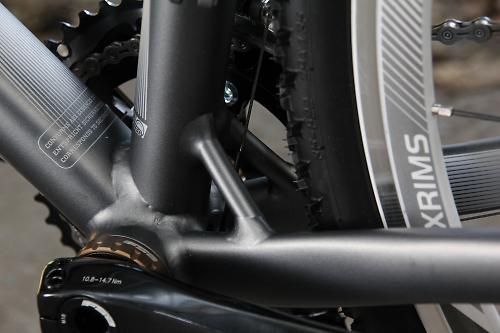
Mud clearance at the rear is achieved by a particularly nifty pair of struts between the chainstays and seattube which replace the typical chainstay bridge.
Clearance around the fork is also good and I never suffered clogging issues despite using this as my sole bike in a number of very muddy races (Northern Champs anyone?).
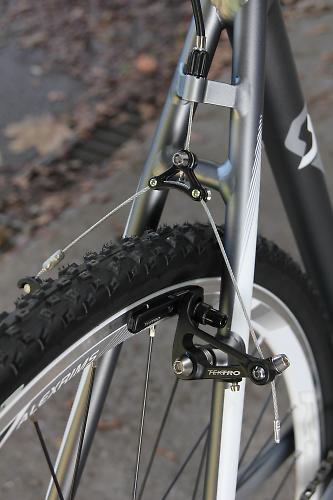
Helping in the clearance stakes is a set of low profile cantilevers. These are provided by Tektro, TRP's parent company, and do about as good a job of stopping you as you could expect from cantilevers on a bike of this price. Brake pad angle is adjustable to allow for some degree of "toe-in" which helped cure some of the brake shudder - at high speeds at least. At low speed, the Comp still displayed a worrying tendency to judder under braking. As with any low profile canti, some people may also have calf clearance issues with the rear brake when out of the saddle.
Speaking of clearances, I found that I had a very slight amount of toe overlap with the front wheel. This characteristic only really made itself known when track stranding at lights and I was never impeded by it while riding or racing.
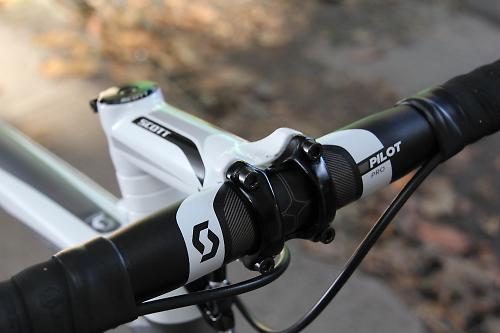
The cockpit comes courtesy of Scott's own house brand and each part performed in a satisfactory manner. The handlebars should suit most people with their medium reach and drop. The aluminium seatpost is a stout 31.6mm in diameter so don't expect any back saving flex. The Selle Italia saddle is also a more upmarket addition although not one of their better known models.
Looking at the spec, the wheels are the only area aspect where it looks like compromises were made to get close to that magical £1000 price limit. The hubs are workman-like affairs (which isn't necessarily a bad thing given the rigours of cyclocross) whilst the Alex rims are heavy and sluggish to whip up to speed. The total package is heavy but on the other hand I haven't had to true the wheels once in the 3 months I've been riding them. If you're looking to get more involved in racing, then this would be one area in immediate need of upgrade.

Despite their bombproof nature, the rim decals are very poorly stuck on and began to peel off almost immediately. A quick once over with a power washer after a particularly muddy race and the rims were left in tatters. Now I know, Alex will probably say that they don't recommend power washing, but this is cross after all – a sport where the power washer is king.
The test bike came with Racing Ralphs which are a significant upgrade from the wire beaded Black Jacks listed on the official spec. For this reason, I won't dwell on them for too long, but I found that they were great all round cross tyres dealing equally well with the fast and dry as with total mudfests. They have also weathered surprisingly well given the reputation of Schwalbe mountain bike tyres for being fast wearing. A good choice if you're thinking of upgrading from the Black Jacks.
At this price point, a mix of Tiagra and 105 is to be expected. Scott have cleverly upgraded the rear mech which is what most people look for first as everything else is Tiagra. My test bike had an issue with some sticky pivots on the rear derailleur which meant that shifting was never 100% (though previous experience with 105 indicates that it's perfectly up job). I wasn't too impressed with the Tiagra shifters however, which were lacking in feedback and often vague on the downshifts.
Shifting precision isn't aided either by the Comp's cable routing. Having exposed cables on the underside of the downtube is a recipe for disaster in muddy conditions. Not only do they clog up with muck in an instant, but they also get in the way when shouldering the bike and I often managed to catch my gloves on them in this way. The cable guides on the underside of the bottom bracket was one area where the cables and housing died pretty much instantly and I was constantly having to replace the housing there. One of the Comp's main competitors, the Specialized Crux, gets around this problem with internal routing but a cheaper option would be to install full length housing.

Gearing wise it's refreshing to see a 36-46 chainring combo on a bike at this price which backs up the Comp's credentials as a race machine. Out back you get a generous 12-30 cassette so they'll be no issue with tackling bridleways and the like. If you're racing though, you'll probably want to invest in something a bit tighter such as a 12-25 as chances are it's probably faster to run if you need anything easier.
Overall weight comes in at a very reasonable sub-10kg (claimed) which is plenty light enough to give racing a go. Chances are you're bike will be gaining a couple of kilos in mud anyway over the course of a race.
Verdict
A super stiff race ready frame which is unfortunately let down by a flexy fork and poor cable routing or at lest lack of cable protection on the chosen route. While it comes with a decent spec list for the price, the aforementioned issues limit its upgrade appeal for someone looking to get more serious about cross.
road.cc test report
Make and model: Scott CX Comp
Size tested: XL Grey and White
About the bike
State the frame and fork material and method of construction. List the components used to build up the bike.
PRODUCT NAME
CX Comp
SIZES
XS/49 S/52 M/54 L/56 XL/58
WEIGHT
9.48 kg / 20.88 lbs
FRAME
Scott Cyclocross frame, 6061 alloy double butted,
replaceable D/O, sloping geometry
FORK
Scott Carbon CX, straight, alloy steerer
HEADSET
TH No 10 CX, ball bearing
DERAILLEUR (REAR)
Shimano 105 new 2012, RD-5700A, 20 Speed
DERAILLEUR (FRONT)
Shimano Tiagra, FD-4600 new
SHIFTERS
Shimano ST-4600, 20 Speed
BRAKES
Tektro CX w. cartridge pads
CRANKSET
FSA Gossamer CX, 46 x 36 T
BB-SET
incl. in crankset
HANDLEBAR
Scott Road Drop OS, Anatomic 31.8 mm
H'STEM
Scott Road Team OS, 1 1/8', four Bolt 31.8 mm
PEDALS
nil
SEATPOST
Scott Alloy 31.6/300 mm
SEAT
Selle Italia Team Edition
HUB (FRONT)
Scott Comp 28 H
HUB (REAR)
Shimano Tiagra, FH-4600
CHAIN
Shimano Tiagra, CN-4600 new
CASSETTE
Shimano Tiagra, CS-4600 new, 10 Speed, 12-30 T
SPOKES
DT Swiss, 2.0mm black
RIMS
Alex Race 28 white, 28 Front / 32 Rear
TIRES
Schwalbe Black Jack, CX 700-35C, wire
Tell us what the bike is for, and who it's aimed at. What do the manufacturers say about it? How does that compare to your own feelings about the bike?
The CX Comp is clearly intended for the budding cross racer who also wants the option of sticking a rack on it and using it on commutes.
Certainly, the rack eyelets are the bike's single concession to utility as the rest of the spec list, and in particular the gearing, is cross ready through and through
Frame and fork
Overall rating for frame and fork
7/10
Tell us about the build quality and finish of the frame and fork?
As you'd expect from a big name like Scott, all the latest technology has been utilised to twist the tubes into complicated shapes. The welds aren't filed so you wouldn't mistake it for a carbon frame but they are neat enough.
Tell us about the materials used in the frame and fork?
Frame is constructed from 6061 Aluminium alloy whilst the fork is carbon with an alloy steerer tube
Tell us about the geometry of the frame and fork?
Middle of the road when it comes to cross bike. A slacker than usual head tube slows down the handling a touch compared to some razor sharp race machines. On trails though, the slackness makes for increased stability at speed and reduces the risk of catapulting over the handlebars
How was the bike in terms of height and reach? How did it compare to other bikes of the same stated size?
Reach is longer than typical euro cross bikes but still shorter than your average road bike.
Riding the bike
Was the bike comfortable to ride? Tell us how you felt about the ride quality.
The ride was stiff and responsive. There's not much inherent comfort in the frame but running your tyres low takes the edge off any bumps anyway
Did the bike feel stiff in the right places? Did any part of the bike feel too stiff or too flexible?
The frame itself was admirably stiff but the flexy fork really lets the whole bike down.
Was there any toe-clip overlap with the front wheel? If so, was it a problem?
A slight amount of toe overlap but only really noticeable when track standing at traffic lights
How would you describe the steering? Was it lively, neutral or unresponsive? Neutral
Tell us some more about the handling. How did the bike feel overall? Did it do particular things well or badly?
A little sluggish round tight, slimy turns, but superb fun on technical singletrack. As a do-it-all off road machine, the Comp was a blast to ride.
Rate the bike for efficiency of power transfer:
8/10
Rate the bike for acceleration:
5/10
Heavy wheels meant it was slow to get up to speed
Rate the bike for sprinting:
6/10
Rate the bike for high speed stability:
8/10
Rate the bike for cruising speed stability:
8/10
Rate the bike for low speed stability:
6/10
Rate the bike for flat cornering:
6/10
Rate the bike for cornering on descents:
7/10
Rate the bike for climbing:
6/10
The drivetrain
Rate the drivetrain for performance:
6/10
Rate the drivetrain for durability:
6/10
Rate the drivetrain for weight:
4/10
Rate the drivetrain for value:
7/10
Wheels and tyres
Rate the wheels and tyres for performance:
6/10
Solid but heavy
Rate the wheels and tyres for durability:
7/10
See review for details
Rate the wheels and tyres for weight:
5/10
Rate the wheels and tyres for comfort:
7/10
The reasonably supple Racing Ralphs have to take credit here
Rate the wheels and tyres for value:
7/10
Controls
Rate the controls for performance:
7/10
Rate the controls for durability:
8/10
Rate the controls for weight:
5/10
Rate the controls for comfort:
8/10
Rate the controls for value:
7/10
Your summary
Did you enjoy riding the bike? Off road - yes. On road - no
Would you consider buying the bike? Better options out there imho
Would you recommend the bike to a friend? No
Rate the bike overall for performance:
6/10
Rate the bike overall for value:
6/10
About the tester
Age: 20 Height: 190cm Weight: 70kg
I usually ride: Giant TCR Advanced 2 My best bike is: Canyon Ultimate CF7
I've been riding for: Under 5 years I ride: Every day I would class myself as: Expert
I regularly do the following types of riding: road racing, sportives, mtb,
For 5 years, racing was my life and I went all the way from a newbie bonking after 40 miles, to a full-timer plying my trade on the Belgian kermesse scene. Unfortunately, the pro dream wasn't meant to be and these days, you're more likely to find me bimbling about country lanes and sleeping in a bush on the side of the road.
Latest Comments
- mdavidford 12 min 14 sec ago
By not driving at them. Although many drivers do seem ignorant of this approach.
- HoarseMann 14 min 54 sec ago
I did buy a Pi camera module with the IR filter removed to have a go at making a lashup ANPR evidence camera. It's still in a drawer. 🤣...
- mdavidford 20 min 31 sec ago
They make an ass out of... um... ptions?
- GMBasix 22 min 41 sec ago
Does the President's colon describe some kind of linguistic abuse, like the grocer's apostrophe?
- BalladOfStruth 42 min 1 sec ago
They weren’t able to conclude beyond all doubt that the driver was at fault from (probably silent) CCTV, but a witness (a front-seat passenger with...
- chrisonabike 1 hour 6 min ago
And in the Netherlands, they're blessing them!...
- Jimmy Ray Will 1 hour 22 min ago
First up... look to see a professional, to rule out anything significant....
- BikxForLikx 1 hour 56 min ago
Hey CadCam, where did you get the connector from? It seems the original links are no longer working?
- qwerty360 2 hours 47 min ago
My understanding is one problem with junctions like Holland Park is the assumption that more lanes + space = higher car throughput....























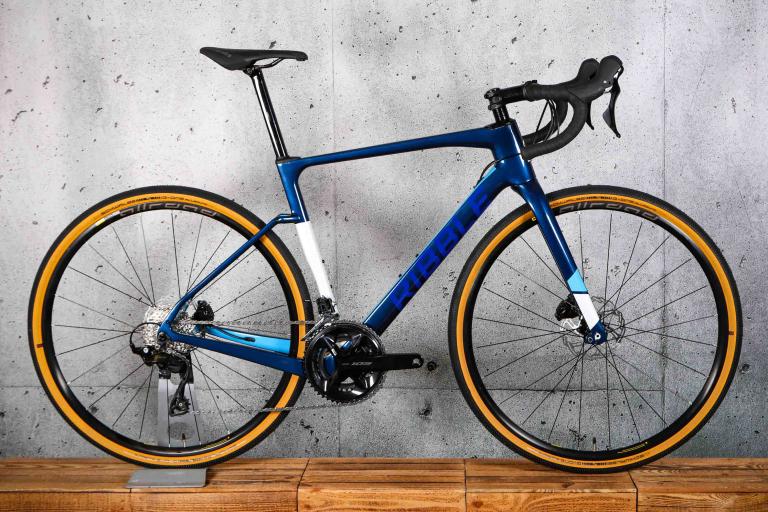
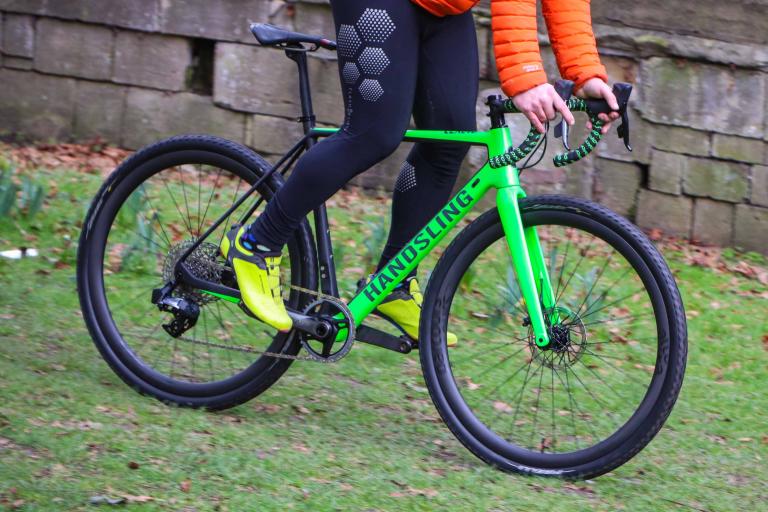

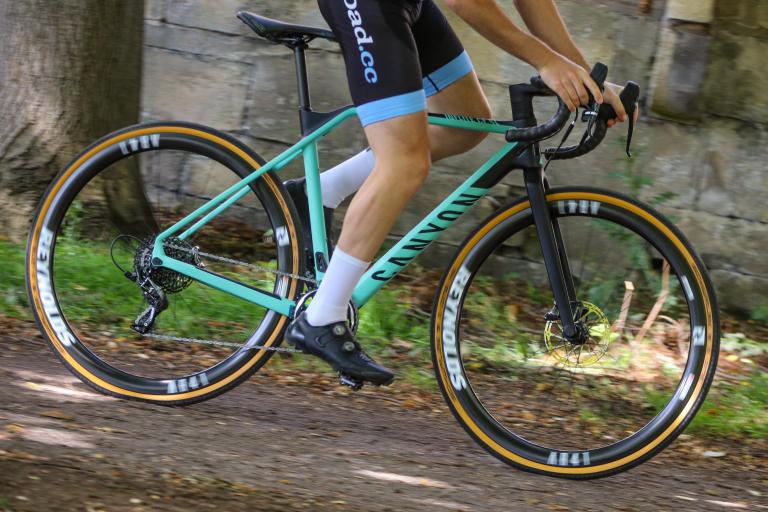
Add new comment
7 comments
Cool - it's definitely worth checking, because I have an Easton EC90X CX fork and if the brakes are set up wrong it judders alarmingly.
That fork is very stiff laterally, but has some fore-aft flexibilty to take the sting out of things.
I used it on a tour, and clattering downhill at 30mph with loaded panniers it the blade tips visibly move, but then no doubt that's why it takes loads more sting and buzz out of the road than the original steel fork.
It's this flex, which can load up the fork like a bow, and the long cable drop to the cantis that can combine to create chatter, especially if the toe-in isn't there to let the braking forces increase in a controlled way. I agree that a fork-mounted cable stop would help alleviate the symptoms too.
I've now updated the review with the results of playing with the pad angle, but here's the gist of it:
At high speeds, the extra toe-in mitigated pretty much all brake shudder. However, once down to around <10km/h, the brake shudder was still present.
While the notion of a laterally stiff, vertically compliant (that old nugget) is great in theory, for an out-and-out cross racer, comfort isn't too high on the list of priorities. Comfort, and more importantly traction, is best achieved by running low pressure tubs rather than a flexy fork imho.
Still no answer on the brakes? Seeing as that's one of the the key criticisms you might want to clarify that.
Hi, after reading your comment I took another look at the brakes and it looks like they are indeed adjustable for toe-in.
I'll be doing some additional testing this weekend to see how this affects handling and will update the review with my findings. However, I don't believe that this will be enough to completely cure the bike's brake shudder and you're still left with a very flexy fork whatever the case.
well, it's not just the cable routing, it's more the fact that the cables are routed that way AND are not properly protected on that more vulnerable route.
There doesen't seem much difference between this and the Caadx 105 (although the caadx seems better equipped on first glance), though the Caadx 105 didn't get slaughtered on the cable routing although it is quite the same.. Why..?
Is it because Caadx 105 isn't really a pure CX bike?
Just wondering
Are those brakes really non-adjustable for toe-in? They look like they should, from what I can see from the pad fixings.
They look really similar to Tektro's CR-720s, which have a rounded cup and washer fitting that gives you bags of adjustment. They definitely don't look like frog legs, that's for sure.
If they aren't adjustable then that's a shocking oversight from Scott. I've ridden CX bikes that had terrible fork judder, but degreasing the rims, a light sanding of the pads and some toe-in got rid of it completely.